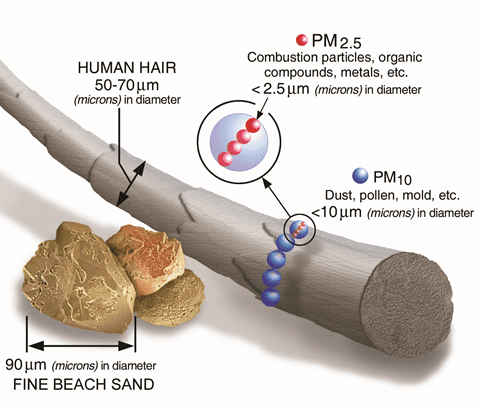The Air Pollution We Can and Can’t See
August 26th, 2021 | viewpoint
It’s 6 pm at the Gangwal Bus Stand in Indore, India. The bus engines rumble as black puffs of smoke come from the exhaust pipes. The passengers stand around waiting for their buses, breathing in the smoke and fumes.
Across the city, people are preparing dinner. The smell of spice mingles with the odor of smoke.
These sights and smells are commonplace, and although many see the smoke darkening the air, there is little thought about the pollutants that we can’t see. Many particles are so small that they can only be detected with a microscope. These are the silent killers.
Misconceptions about the sources and health consequences of air pollution are common. Before action to mitigate air pollution can be taken, we must understand which particles are causing the most harm and their concentration in the air we breathe.
Air sometimes contains a mixture of solid particles and liquid droplets that pollute it. This is called particulate matter (PM). When we want to measure PM in the air, there are usually size cut-offs: anything below 10 microns, which includes dust, soot, mold, and pollen; and anything below 2.5 microns, which includes car emissions, cooking with biofuels, burning trash, and industrial processes. Our bodies naturally protect us from the larger particles by trapping them in our nose and throat. The finer particles are not trapped and can get deep into our lungs. So while PM10s are larger and can make things look really dirty, PM2.5s are actually the most dangerous to our health.

The USAID-funded Building Healthy Cities (BHC) project is working in Indore to increase community understanding of air pollution. In partnership with Indore Smart City Development Limited, Indore School of Social Work, SkyMet, and TD Environmental Services, BHC has trained and continues to work with 20 clean air guides (CAGs) from across the city.
BHC also installed 20 low-cost air quality sensors across Indore. Each CAG focuses on one air sensor in his/her neighborhood and helps community members understand and find solutions to air quality problems.

At the first training, many of the CAGs expressed concern about dust. Vani Joshi said “in day-to-day life we all see dust particles floating in the air, they are more visible in sunlight.” Through the BHC training, the CAGs learned about the body’s natural processes for trapping larger particles like dust, and that those we cannot see are the greater concern. THe CAGs learned to interpret the data collected by the air quality sensors, which include PM10 and PM2.5 levels.

Once the CAGs understand the air pollution context, they work with their communities to find sustainable solutions, from planting trees to meeting with business owners and city officials.
We strive to build lasting relationships to produce better health outcomes for all.